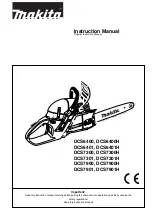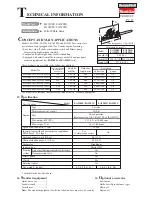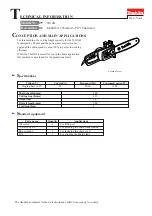
30
Greenlee Fairmont Textron / Subsidiary of Textron Inc.
4455 Boeing Drive, Rockford, IL 61109 815/397-7070
Pistol Grip Chain Saw
GREENLEE
FAIRMONT
Appendix A
Improper selection, installation or maintenance
may result in premature failures, bodily injury, or
property damage.
2. SELECTION
The following is a list of factors which must be considered
before final hose selection can be made.
2.1 Pressure - After determining the system pressure,
hose selection must be made so that the recommended
maximum operating pressure is equal to or greater than
the system pressure. Surge pressures higher than the
maximum operating pressure will shorten hose life and
must be taken into account by the hydraulic designer.
2.2 Suction - Hoses used for suction applications must be
selected to insure the hose will withstand the negative
pressure of the system.
2.3 Temperature - Care must be taken to insure that fluid
and ambient temperatures, both static and transient, do
not exceed the limitations of the hose. Special care must
be taken when routing near hot manifolds.
2.4 Fluid Compatibility - Hose selection must assure
compatibility of the hose tube, cover, and fittings with fluid
used. Additional caution must be observed in hose selec-
tion for gaseous applications.
SELECTION, INSTALLATION AND MAINTENANCE OF
HOSE AND HOSE ASSEMBLIES
- SAE J1273 MAY 1986*
SAE RECOMMENDED PRACTICE
The following recommendations on selection, installation
and maintenance of hose and hose assemblies was
established by the S.A.E. in 1979 and reaffirmed May
1986. Please read these general instructions carefully.
1. SCOPE
Hose (also includes hose assemblies) has a finite life and
there are a number of factors which will reduce its life.
This recommended practice is intended as a guide to
assist system designers and/or users in the selection,
installation, and maintenance of hose. The designers and
users must make a systematic review of each application
and then select, install, and maintain the hose to fulfill the
requirements of the application. The following are general
guidelines and are not necessarily a complete list.
2.5 Size - Transmission of power by means of pressur-
ized fluid varies with pressure and rate of flow. The size
of the components must be adequate to keep pressure
losses to a minimum and avoid damage to the hose due
to heat generation or excessive turbulence.
2.6 Routing - Attention must be given to optimum routing
to minimize inherent problems.
2.7 Environment - Care must be taken to insure that the
hose and fittings are either compatible with or protected
from the environment to which they are exposed. Environ-
mental conditions such as ultraviolet light, ozone, salt
water, chemicals, and air pollutants can cause degrada-
tion and premature failure and, therefore, must be con-
sidered.
2.8 Mechanical Loads - External forces can significantly
reduce hose life. Mechanical loads which must be consid-
ered include excessive flexing, twist, kinking, tensile or
side loads, bend radius, and vibration. Use of swivel type
fittings or adapters may be required to insure no twist is
put in the hose. Unusual applications may require special
testing prior to hose selection.
2.9 Abrasion - While a hose is designed with a reason-
able level of abrasion resistance, care must be taken to
protect the hose from excessive abrasion which can result
in erosion, snagging and cutting of the hose cover.
Exposure of the reinforcement will significantly accelerate
hose failure.
2.10 Proper End Fitting - Care must be taken to insure
proper compatibility exists between the hose and coupling
selected based on the manufacturer’s recommendations
substantiated by testing to industry standards such as
SAE J517d (November, 1976).
2.11 Length - When establishing proper hose length,
motion absorption, hose length changes due to pressure,
as well as hose and machine tolerances must be con-
sidered.
2.12 Specifications and Standards - When selecting hose,
government, industry, and manufacturer’s specifications
and recommendations must be reviewed and applicable.
2.13 Hose Cleanliness - Hose components vary in
cleanliness levels. Care must be taken to insure that the
assemblies selected have an adequate level of cleanli-
ness for the application.
2.14 Electrical Conductivity - Certain applications require
that the hose be non-conductive to prevent electrical
current flow. Other applications require the hose to be
sufficiently conductive to drain off static electricity. Hose
and fittings must be chosen with these needs in mind.



































